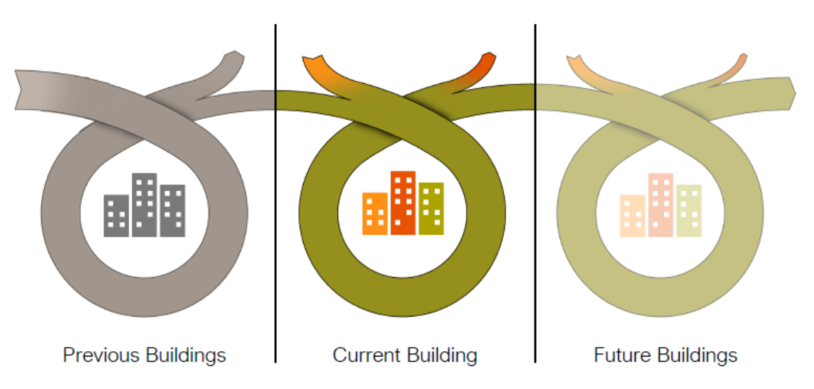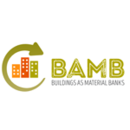Circular Building Assessment
Contents |
 Definition
Definition
Circular Building Assessment is an assessment approach and method that aims to provide a holistic evaluation and interpretation of multiple sustainability aspects of buildings and their parts.
Taking a life cycle approach, aspects that are included are the environmental impact, financial costs, health consequences and social value of the object under study. Developed within the BAMB-project, Circular Building Assessment fosters better informed decision-making about ‘circular’ alternatives compared to linear, business as usual options.
Guidelines
Environmental impacts of construction products and buildings are typically evaluated using life cycle assessments (LCA), and financial impacts by means of life cycle costing (LCC). Conventionally, their implementation is not without flaws. Despite European standards and recommendations, modelling closed material loops is not harmonised across the continent for example.
Also, social value assessments are many and varied, covering a plethora of aspects of societal costs and benefits. Moreover, most metrics in conventional societal impact or value studies, do not have a relevance when rethinking value networks in construction, and the economy in general. Therefore, a mayor revision of those assessment methods was indispensable.
Circular Building Assessment is facilitated through data extraction from Building Information Modelling (BIM) and Material Passports where available. Consequently, from a certain level of detail, an evaluation of the transformation capacity and reuse potential of the building and its key parts can affect the assessment outcomes for all aspects.
Moreover, the BAMB project aims to compare within the Circular Building Assessment method the overall impact of the replacement of new products with reclaimed ones, of service life extensions resulting from improved transformation capacity, and the future reuse of parts enabled by their increased reuse potential. (Read more at https://www.bamb2020.eu/topics/data-decision/)
Related terms
- Life cycle, life cycle phases: The series of consecutive and interlinked stages a building or part passes through, from production, over operation and transformation to its end of life.
- Service life, estimated service life: The period a building or part meets or is expected to meet a set of requirements given a set of in-use conditions, determined from reference service life data.
- Life cycle assessment, LCA: A procedure for evaluating the lifetime environmental impact of a building, or building part, including scope definition, inventory analysis, impact assessment, and interpretation.
- Life cycle costing, LCC: A procedure for evaluating the financial impact of a building, or building part, over an agreed period of analysis and as defined in a predetermined scope.
- Scenario: a collection of assumptions concerning an expected, or challenging, sequence of future events, such as building transformations, price evolutions and any technical development.
References
CEN (2011) EN 15978 Sustainability of construction works, Assessment of environmental performance of buildings – Calculation method. European Committee for Standardisation.
CEN (2015) EN 16627 Sustainability of construction works, Assessment of economic performance of buildings – Calculation methods. European Committee for Standardisation.
European Commission (EC) (2013), Annex II: Product Environmental Footprint (PEF) Guide to the Commission Recommendation (2013/179/EU) on the use of common methods to measure and communicate the lfe cycle environmental performance of products and organisations.
EeBGuide (2012) Operational Guidance for Life Cycle Assessment Studies of the Energy Efficient Buildings Initiative. Accessed March 2017 via www.eebguide.eu
ISO (2006) ISO 14040-0 Environmental management, Life cycle assessment – Part 0 Principles and framework. International Organisation for Standardisation.
--BAMB - Buildings As Material Banks 09:50, 15 Aug 2018 (BST)
Related articles on Designing Buildings Wiki
About the wiki
Anyone is welcome to use and contribute to the wiki in different ways.
[edit] Engaging with the wiki
You can:
- Contribute to existing articles
- Create articles
- Share articles through social media and other channels
- Contact the CIRCuIT project to let us know what you think and how we can improve
[edit] Add your own content
To contribute to or create an article, you can follow these steps:
- Register as a user
- Read through the editorial policy and guidance on writing and contributing to articles
- See the detailed help page on tips on writing wiki articles
- Try editing a test article
- If editing an article, select 'Edit this article' underneath the article title
- If creating a new article, select 'Create an article'. In the 'Select categories' area, expand the 'Industry context' list and tag 'Circular economy' to add your article to this wiki
[edit] Who is this wiki for?
The articles contain information on implementing circular economy approaches in construction that could be relevant to:
- Architects
- Construction contractors
- Designers
- Developers, owners, investors
- Engineers
- Landowners
- Manufacturers and supplier
- Universities and research
- Urban planners
[edit] About CIRCuIT
The Circular Economy wiki is supported by the Circular Construction in Regenerative Cities (CIRCuIT) project, which is funded by the European Union's Horizon 2020 research and innovation programme. CIRCuIT is a collaborative project involving 31 ambitious partners across the entire built environment chain in Copenhagen, Hamburg, Helsinki Region and Greater London. Through a series of demonstrations, case studies, events and dissemination activities, the project will showcase how circular construction practices can be scaled and replicated across Europe to enable sustainable building in cities and the transition to a circular economy on a wider scale.







